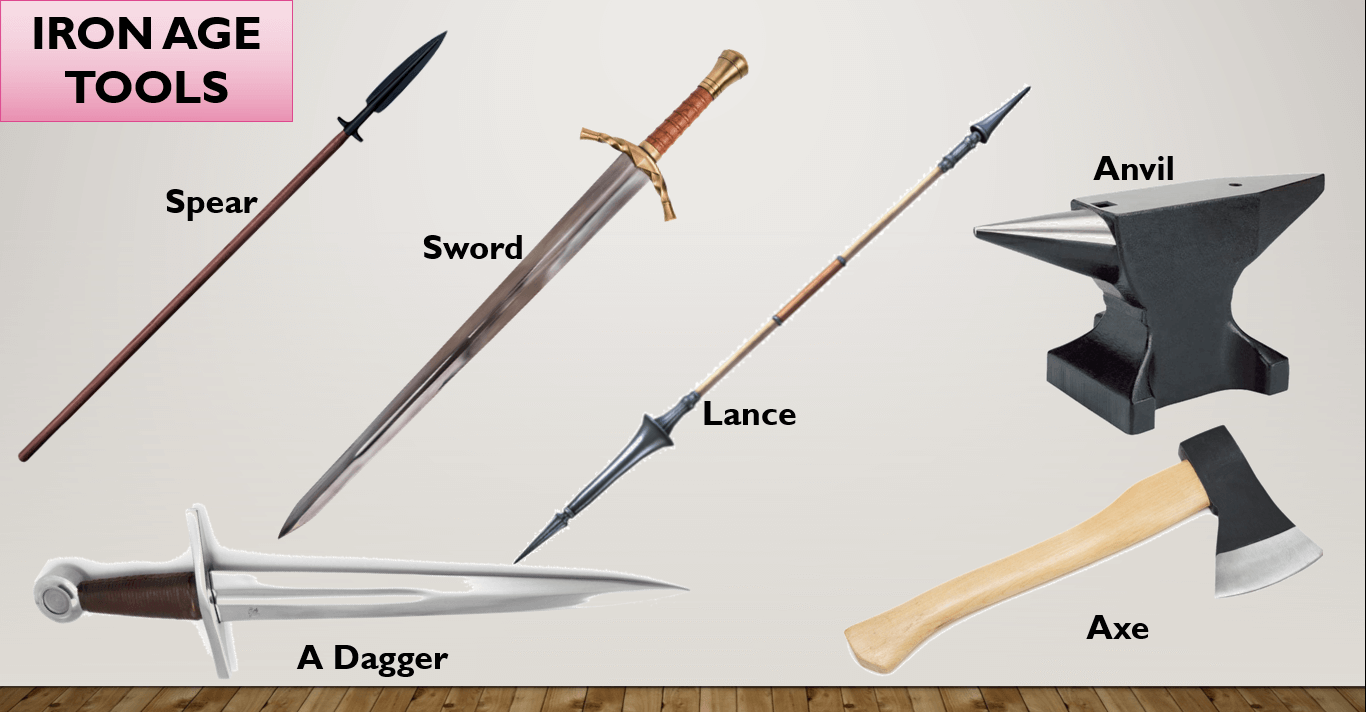Iron age tools are weapons and equipment made of iron, which eventually replaced the bronze tools. The iron age is the period when people of different locations learned how to use iron for weapons and tools.
During this period, different technologies were employed to produce iron tools and equipment. Smelting was a predominant iron age technology used to fabricate iron age tools and weapons.
The iron age changed the face of human civilization and the pattern of production. The key importance of the iron age is the solution to the shortage of farming implements and more durable tools.
This lesson is important for students in Junior Secondary Schools and covers the curriculum on the Iron Age. In this lesson you will learn the following:
- What is the iron age?
- What are the iron age tools and weapons?
- What is iron age technology?
- The importance of the iron age
The diagram below summarizes this study and helps the student memorize the entire study in minutes.
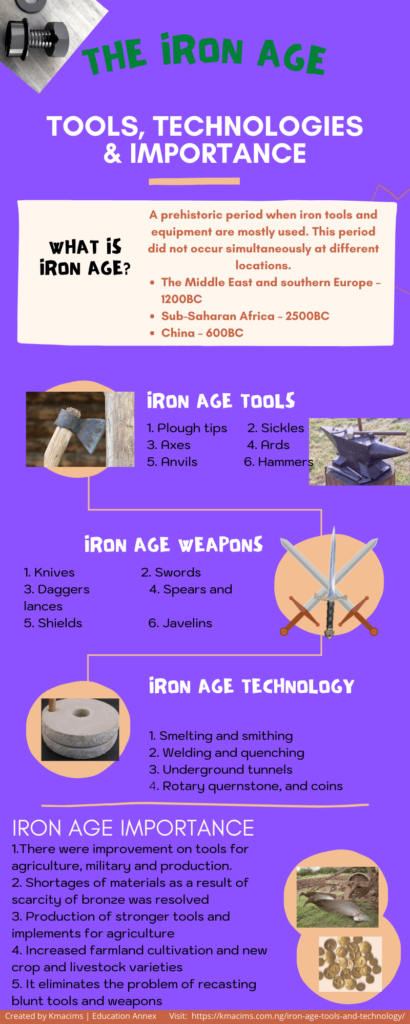
What is Iron Age?
The iron age is a prehistoric period when iron tools and equipment are mostly used in production. This period did not start at the same time throughout human existence. It occurred at different periods in different parts of the world.
For example, it started in the Middle East and Southern Europe in 1200 BCE. Before this period, iron had limited use in this region. This is might be because the people do not understand its superior quality to bronze.
According to studies, iron metallurgy started between 3000 and 2500BCE in Africa. The Nok culture in Nigeria was discovered to have practiced iron smelting at about 550BC.
In China, the iron age started around 600 BCE. As time goes on, the knowledge of iron metallurgy and iron implements became widespread. Iron implements, tools, and equipment spread all over and became predominant in human history for about 2000years.
The iron age is the third stage of human civilization. It follows the Stone Age and the Bronze Age. However, in African civilization, the iron age followed the stone age. This is because iron and bronze diffused into Africa in the same period.[1]
The transition from the bronze age
After the stone age, bronze implements became predominant and were used for tools and weapons. Bronze is made up of tin and copper. Over time, tin became scarce, which led to a decline in the production of bronze tools.[2]
As time goes on, people began to source a substitute for bronze. But because of the predominant presence of iron, iron became an option. The only problem was that iron has a higher melting point than bronze.
Gradually, people began to produce iron tools by heating and hammering. When iron is heated at a high temperature, it becomes softer, then a hammer is used to shape the tool. This system continued until the temperature of furnaces was increased to make different shapes out of iron ore.
Over time, carbon was added to iron to produce steel. When tin became available again, iron was discovered to be cheaper, stronger, and lighter. This made iron tools and weapons permanently replace the bronze implements.
Iron Age Tools and Weapons
The first 3 stages of civilization were a period of an agrarian society. People cultivate the soil to produce food. Hence, tools and implements made at this time were mostly used for agriculture and protection against invaders.
The iron age tools and weapons are the classes of tools and weapons predominantly used by people at that time. Iron age tools are implements and equipment made to aid farming and agriculture, especially, clearing and sol cultivation.
The iron age weapons are portable implements used for protection and military actions. People use weapons to wage war as well as protect themselves against invaders.
Iron age tools
Iron age tools are used for cultivation, woodwork, agricultural activities, and production of other tools. Some of them include:
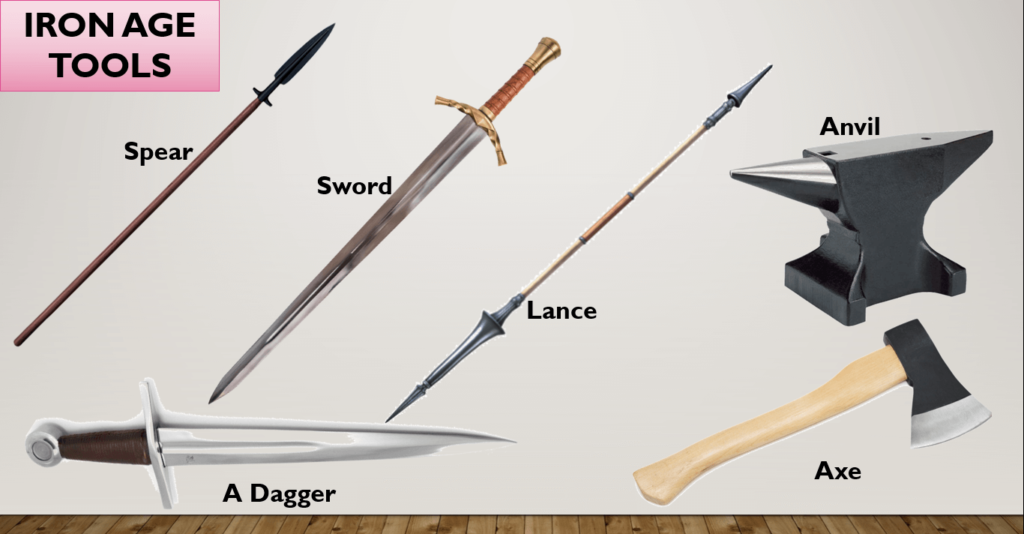
- Plough tip – This is a hard iron blade that is usually pooled by animals. Plough is used in tilling tougher soils.
- Axes – These are heavy iron blades with a wooden handle used for breaking woods, and falling trees.
- Sickles – This is a curved knife made of iron with a wooden handle. It is used for cutting grass and harvesting crops.
- Shovels and hoes – Shovels and hoes are flat metals with wooden or metal handles used for tilling the ground.
- Ards – art is a tool with an iron tip and wooden handle. It is used for tilling the ground.
- Anvils – This is a big iron block that is used as support for hammering and shaping metals. They are mostly used by the blacksmiths.
- Hammers – These are tough iron heads with wooden or metal handle used to break and shape objects. Hammers have different shapes and toughness depending on what they use.
- Chisel – This is a flat-shaped iron object used for breaking woods, metals, and hard objects.
Iron age weapons
Iron age weapons are used for protection and military action. Some of them are:
- Knife – This is a metal blade with one sharp face used for cutting. It can have a wooden handle.
- Swords – This is a long weapon made of iron or bronze. It has two sharp faces with a handle.
- Spears and lances – These are weapons made of long wooden objects with pointing iron tips.
- Daggers – Daggers are like swords but are shorter and can easily be hidden on the body.
- Shield – This is an oval metal used for protection. When the enemy attacks, shields are used to protect from attack, especially in military action.
- Javelin – This is a projected weapon with long iron body. It is used to attack an enemy from a distance.
Iron Age Technology
During the iron age, tools, weapons, and implements were made using iron as the chief material. Iron age technology includes the process of producing tools and implements through ironworking and inventions made as a result.
Iron age technology, therefore, includes the following production processes.
Smelting
Smelting is the process of producing metal from its ore through excessive heating. When excessive heat is applied, you can extract a base metal from the ore.
Smithing
Smithing is the process of fabricating a metal using heating and hammering. When you heat metal to become red hot, you can heat it to form a shape. This is one of the processes used by the blacksmiths.
Welding
Welding is the process of fabricating metals by joining metals together using a specialized heating process.
Furnace
A furnace is a heating unit used to melt metals and other substances at high temperatures.
Quenching
Quenching is the process of making iron stronger and more brittle. Using this process, iron can be transformed into steel.
The iron age technology led to inventions and innovations that powered human civilization, settlements, and the security of lives and properties. Notable inventions of the iron age include:
Security of lives and properties
The iron age ushered in complex security systems and military action. Different cities were able to build strong gates and wall their cities to protect lives and properties from intruders.
Underground tunnels
Before the iron age, people began to invade other communities to loot and do away with their bronze. This was because bronze was scarce at that time. Communities can be held under siege for a long. But the iron age technology led to the construction of underground tunnels. The tunnels connect to springs and lead people to the waterways during a period of siege.
Coins
Coins that are imprinted for exchange appeared for the first time in the iron age. Coins first appeared in Lydia at about 600BC and were used as a form of currency.
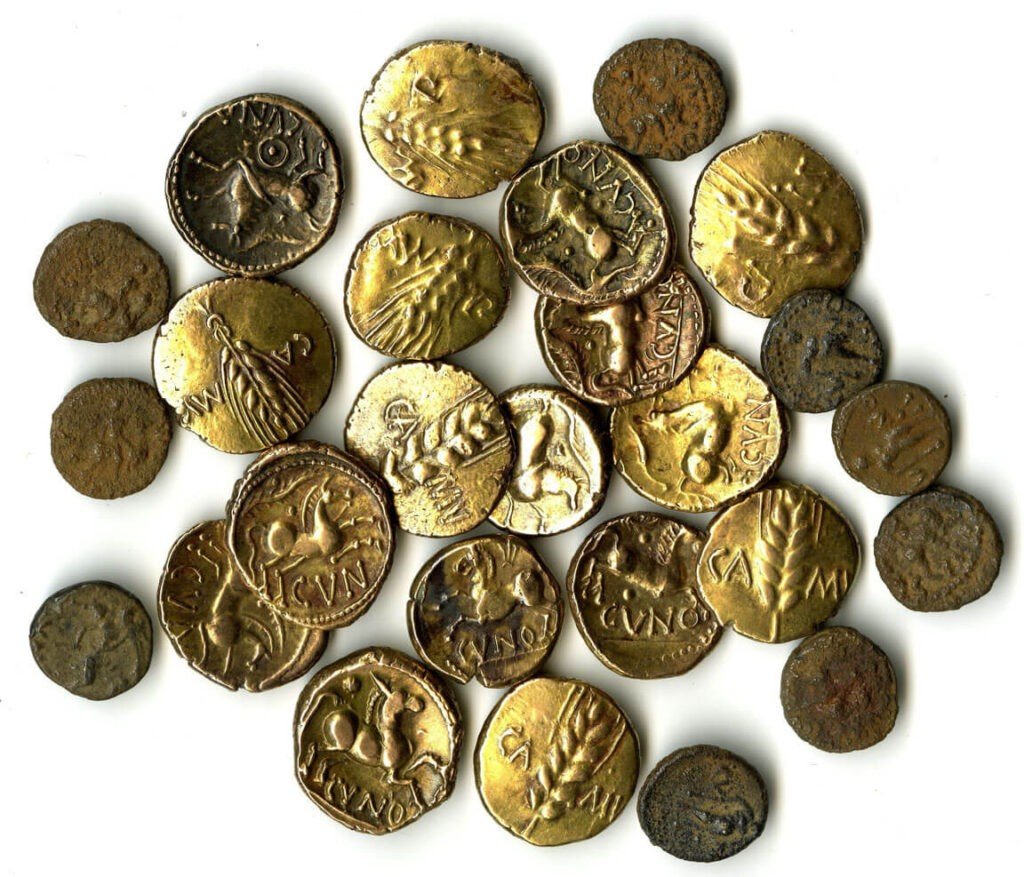
War weapons and farming tools
The iron age led to the production of more sophisticated weapons for military action. War weapons such as spears and arrows, plate armors, chains, and chariots were produced.
Also, there was massive production of farming tools that aided farmland cultivation. Farming tools such as iron ax, sickle, cutlasses, hoe, etc., were produced, and they made farming more efficient and productive.
Plough tip
The production of plow tips made it possible for people to cultivate tougher soil with greater efficiency. It also speeds up cultivation and increased agricultural production.
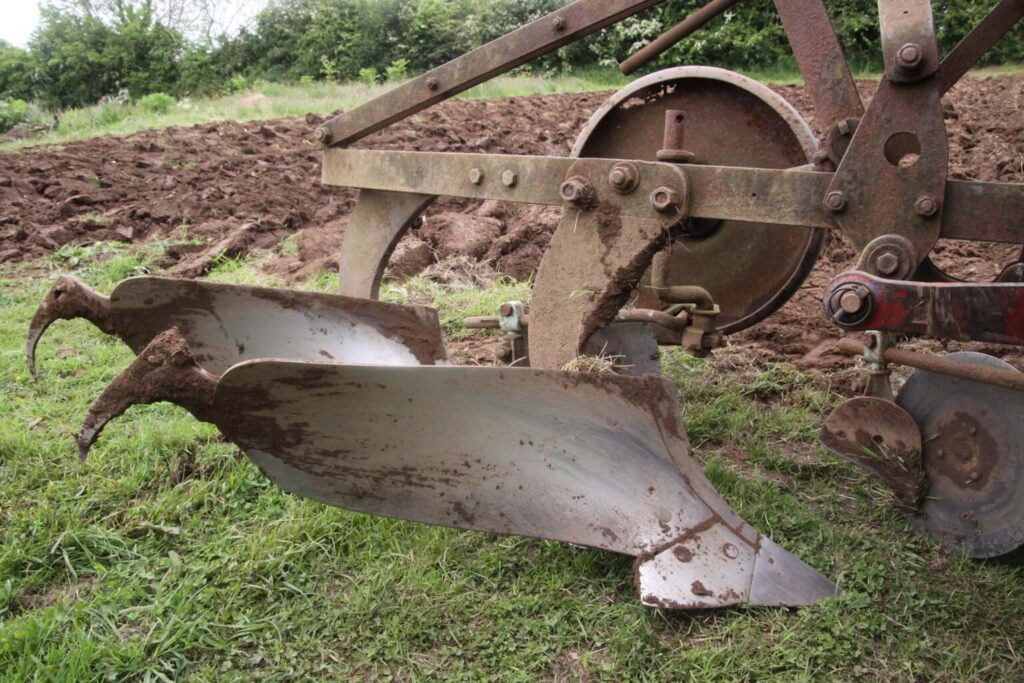
Rotary quern
This is a domestic tool or mechanical machine used for grinding grains. It is made up of two circular stones, the top, and the bottom. The top stone usually has a hole and a handle and moves in a circular direction to grind grains. When you pour grain and rotate the top stone, the grains are grounded on the bottom immovable stone.
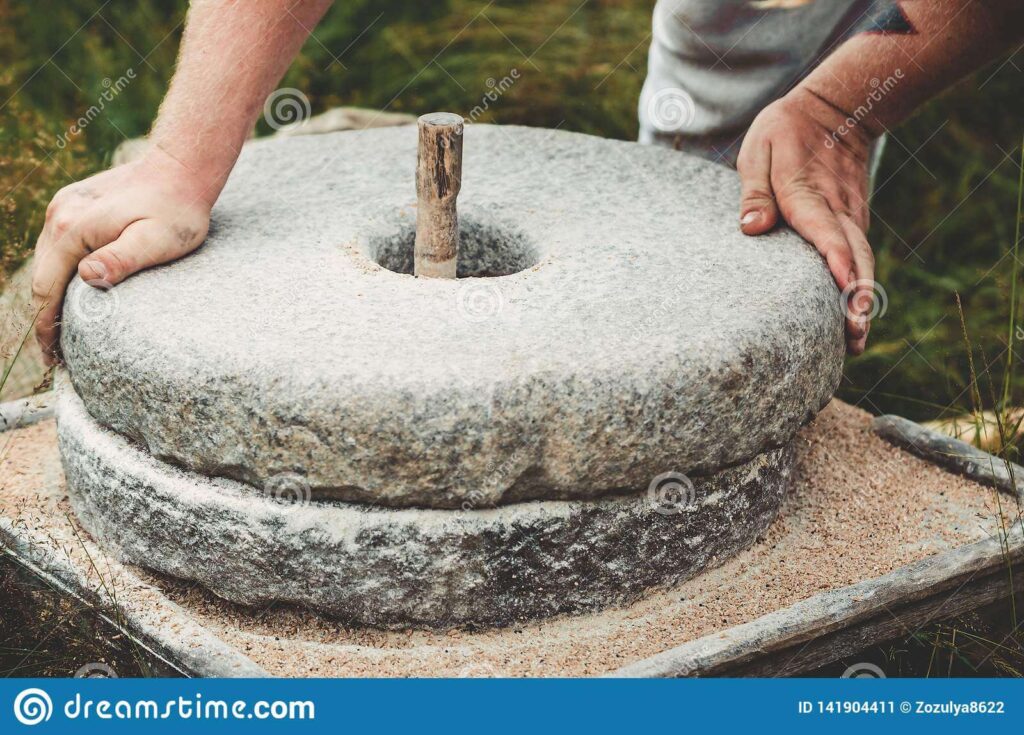
Importance of Iron Age
The following importance of the iron age should be noted. They include:
- Though the bronze age made available tools and weapons for agriculture, military, and production, iron improved on them.
- The introduction of iron helped to solve the problem of the shortage of tools and implements created by the scarcity of bronze.
- Iron led to the production of stronger tools for the breaking and tilling of tougher soils for agriculture.
- There was the introduction of new varieties of crops and livestock
- It also led to expanded and increased farmland cultivation which improved agricultural production.
- Iron eliminated the problem of recasting blunt and dull weapons and tools. Instead of recasting, blunt edges are sharpened.
- New ways of smelting and working with metals are developed.
- Iron changed the pattern of settlement. People were able to move and resettle from one place to another.
- Iron made possible the production of steel tools and weapons which are much stronger than bronze.
- Military actions and an enhanced system of warfare were developed.
Significance of the iron age in African civilization
The iron age has the following significance in Nigeria and West Africa:
- Iron was vital to the rise of Dahomey, Benin, and Yoruba kingdoms in Nigeria
- It brought the exchange of knowledge and spiritual belief system in Nigeria
- It led to the origin and importance of blacksmithing in West Africa
- Blacksmiths used iron to produce agricultural tools, war weapons, and protective covers.
- Blacksmiths were admired because it is believed that ironworking has a closeness with spiritual powers.
- Blacksmiths were socially and politically powerful, and invaluable in major communities.
- People with ironworking skills can travel and settle anywhere at will because of their specialized knowledge.
Conclusion
The iron age tools and technology led to advancement in human society. It is a period that brought about the massive use of iron tools and implements for efficient agricultural production. Also, stronger weapons are produced for defense.
Iron age tools include plow tips, hoes, knives, etc., while iron age weapons include spears, arrows, etc. These tools and weapons helped in farm cultivation and protection during the era.
Iron age technology saw the use of smelting, smithing, quenching, and welding to fabricate stronger tools. Notable inventions during this era include plow tips, chariots, coins, tunnels, and iron gates.
There are other iron age tools, weapons, and technologies that we cannot cover in this article. I believe that the tools, weapons, and technology of the iron age discussed so far will help students understand the era.
[1] The idea of whether iron diffused into sub-Sahara Africa or was discovered in Africa is still a subject of discussion by scholars.
[2] https://study.com/academy/lesson/iron-age-definition-characteristics-importance.html#lesson-quiz-question-cta

